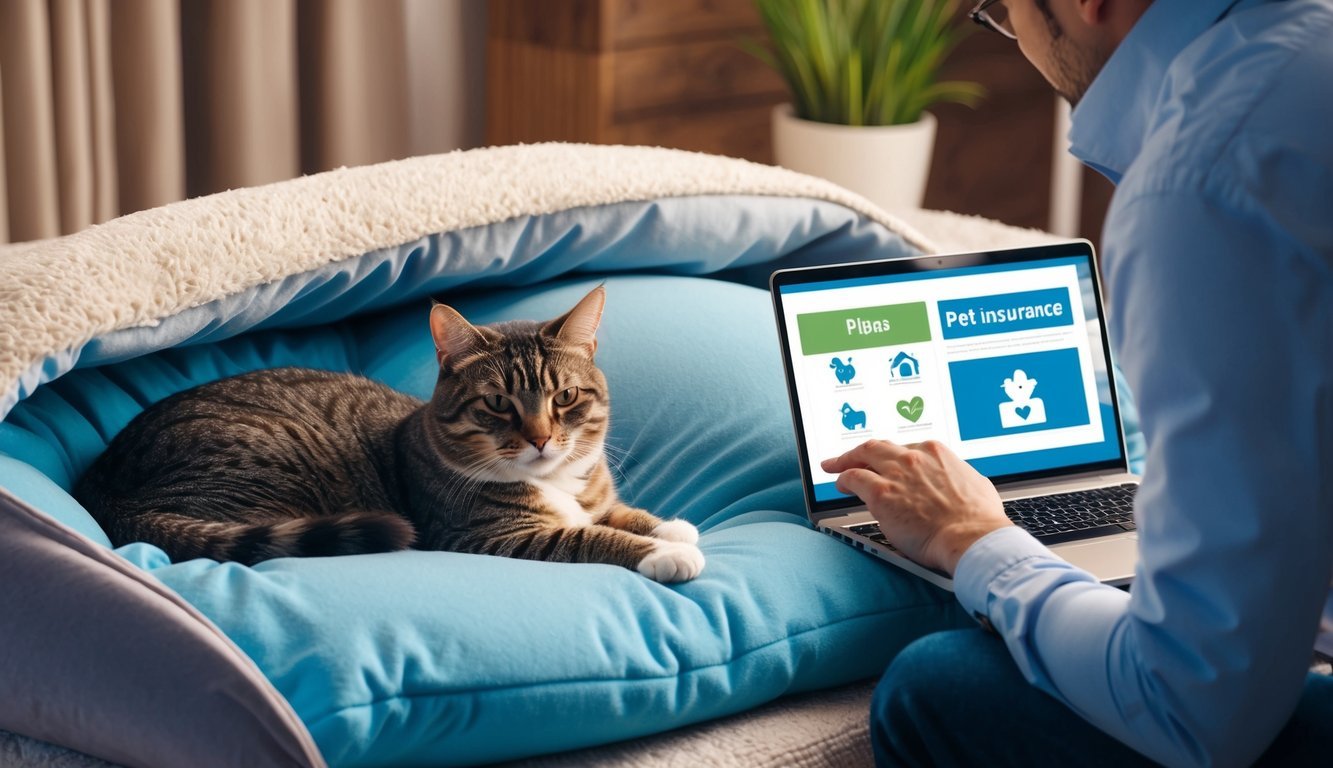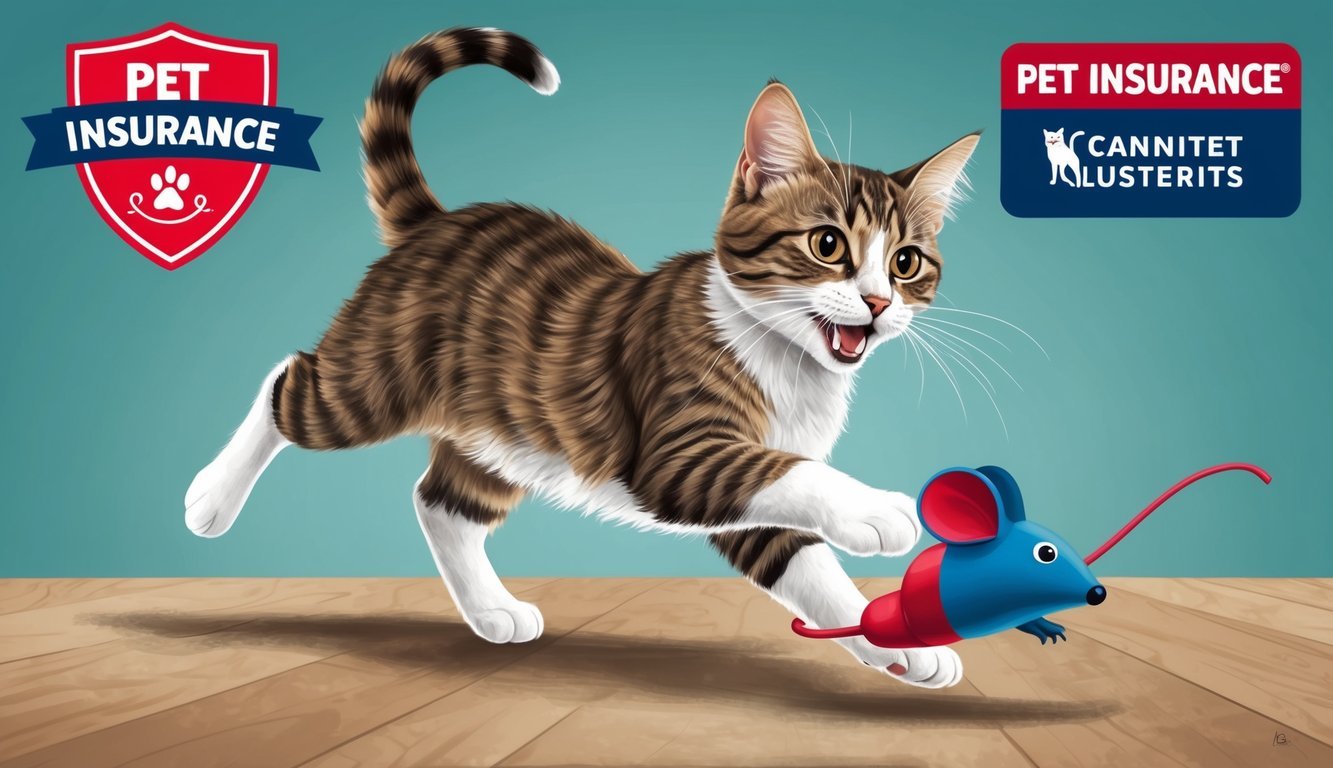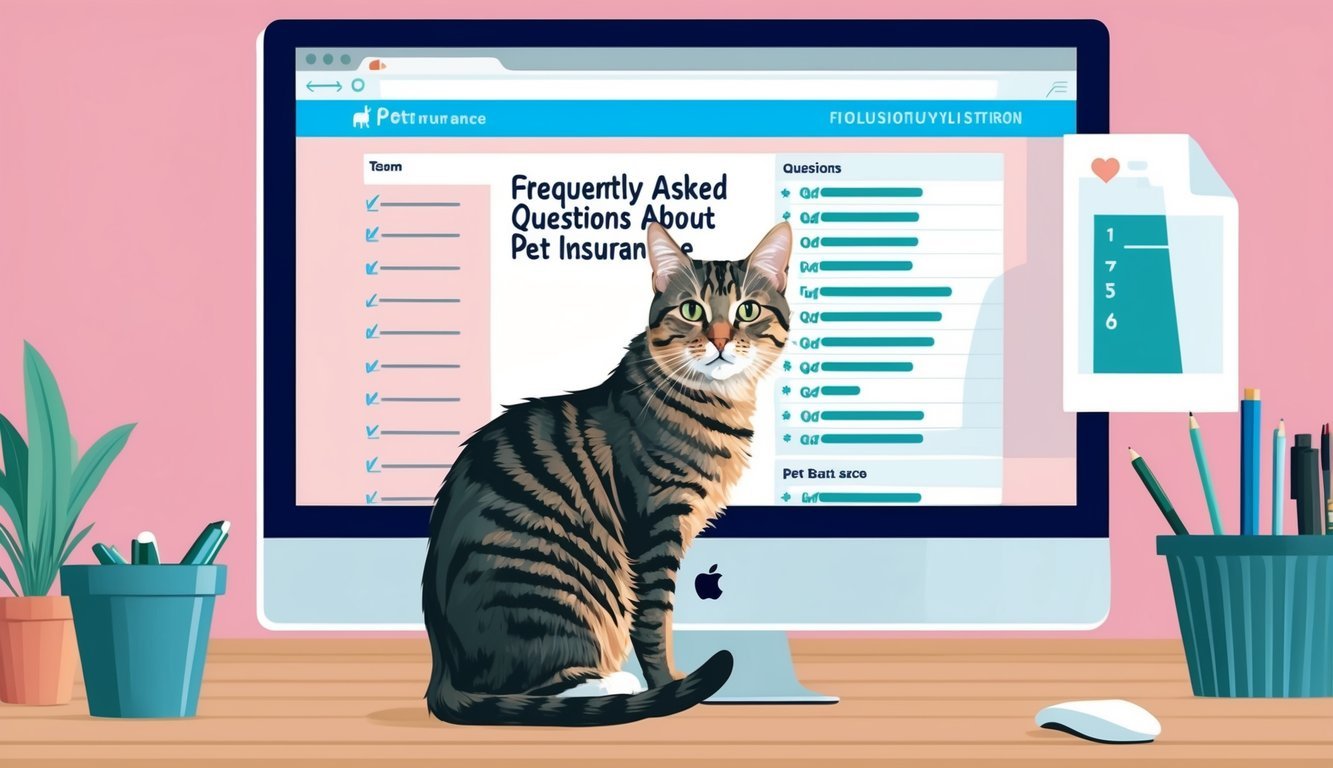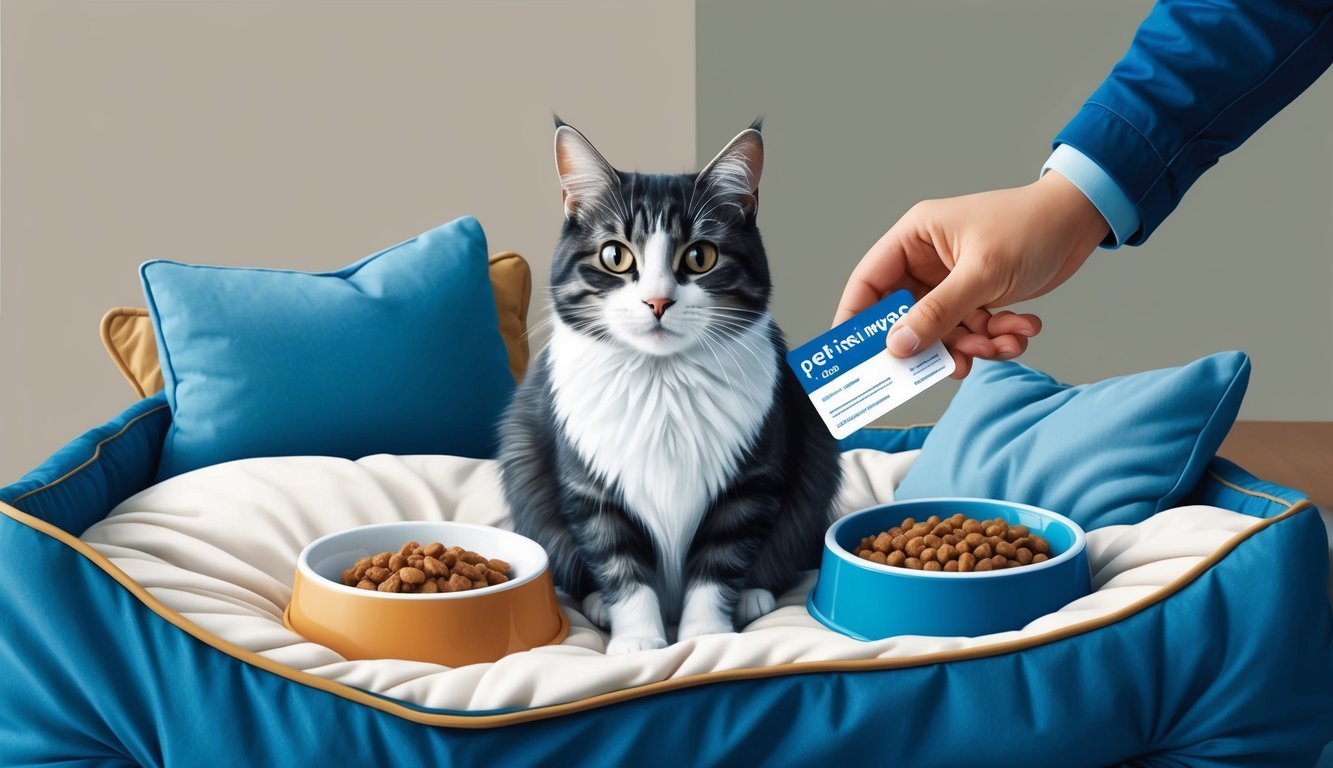Pet insurance for cats is a smart choice for any cat owner looking to safeguard their furry friend’s health.
With cat insurance, you can protect yourself from unexpected veterinary bills due to accidents or illnesses.
Many pet insurance plans offer options to customize your coverage, making it easier to find a plan that suits both your budget and your cat’s specific needs.
Navigating the various types of cat insurance can seem daunting, but understanding the essentials can lead you to the right policy.
Options range from basic accident-only plans to more comprehensive coverage that includes illnesses and wellness services.
With the right insurance, you can ensure that your cat gets the care they deserve without breaking the bank.
Key Takeaways
- Protect your finances with cat insurance to cover unexpected vet costs.
- Explore different types of coverage to find the best fit for your needs.
- Research reputable providers to ensure your cat gets quality care.
Understanding Pet Insurance for Cats
Pet insurance plays a crucial role in managing the health care costs for your feline companion.
It covers various types of expenses, helping you focus more on your cat’s well-being.
Here’s what you need to know.
What Is Pet Insurance?
Pet insurance is a policy that helps cover veterinary costs for your cat.
There are different types of plans, including accident-only and wellness coverage.
- Accident-only plans cover unexpected injuries.
- Wellness plans often include routine check-ups and vaccinations.
With these policies, you typically pay a monthly premium, an annual deductible, and a percentage of the veterinary costs after reaching your deductible.
Understanding your options allows you to choose the best fit for your needs.
How Does Cat Insurance Work?
Cat insurance operates on a reimbursement model.
First, you visit the vet and pay the bill upfront.
After that, you submit a claim to your insurance provider.
Depending on your plan, you can expect reimbursements of about 70%, 80%, or even 90% of the total cost.
Reimbursements are calculated based on the cost minus the deductible you set when enrolling in the plan.
This structure helps manage both routine and emergency expenses effectively.
Importance of Insurance for Your Feline Friend
Having pet insurance for your cat is essential for several reasons.
-
Financial Protection: Unexpected illnesses or accidents can lead to high veterinary bills. Insurance helps mitigate these expenses.
-
Peace of Mind: Knowing you have financial support allows you to make necessary health decisions without worrying about the cost.
-
Comprehensive Care: Many plans cover a variety of illnesses and treatments, including surgeries and medications.
-
Prevention: Some policies offer wellness coverage, encouraging you to keep up with vaccinations and regular vet visits.
Even if your cat is healthy now, having insurance ensures you’re prepared for any future health challenges.
Types of Cat Insurance Plans

Understanding the different types of cat insurance plans helps you choose the right coverage for your furry friend.
Each plan type offers various benefits tailored to specific needs and preferences.
Accident-Only Plans
Accident-only plans are designed specifically for emergencies resulting from accidents.
If your cat gets injured in a fall or gets into a fight, this plan can help cover the costs.
Key features include:
- Lower premiums compared to other plans.
- Focus solely on accident-related expenses.
- Limited coverage for illnesses or routine care.
These plans are ideal for owners who want basic coverage for unexpected incidents without a hefty monthly payment.
Wellness and Preventative Care
Wellness and preventative care plans focus on keeping your cat healthy before issues arise.
They usually cover routine visits and essential vaccinations.
Typical inclusions are:
- Annual wellness exams
- Vaccinations
- Fecal exams and parasite treatments
These plans often come at an additional cost but offer peace of mind, ensuring your pet receives necessary preventative measures to avoid illnesses.
Comprehensive Coverage Options
Comprehensive plans are your all-in-one solution.
They usually combine accident, illness, and wellness coverage into a single package.
You can expect:
- Coverage for both unexpected accidents and illnesses.
- Options for wellness treatments and routine checks.
- Various deductible and reimbursement levels to customize costs.
This type of plan offers extensive financial protection, catering to all aspects of your pet’s healthcare needs, making it suitable for those who want the most robust coverage.
Coverage Specifics and Exclusions

When considering pet insurance for your cat, it’s crucial to understand what is typically covered and what is not.
Key areas include pre-existing conditions, routine care, and hereditary or congenital conditions.
Each of these factors can significantly impact your insurance experience.
Pre-Existing Conditions
Most insurance providers exclude pre-existing conditions from coverage.
This means if your cat had an illness or injury before you purchased the policy, treatment related to that issue won’t be covered.
It’s important to disclose your cat’s full medical history to avoid surprises later.
Some companies may offer limited coverage or modifications if the condition is considered “curable” and has been free of symptoms for a specified period.
Always read the fine print and clarify any uncertainties with the provider to ensure you understand their policies.
Routine Care and Wellness
Routine care is often excluded from standard policies but may be available as an add-on or wellness plan.
Basic routine care includes vaccinations, annual check-ups, and flea control.
Preventive care options aim to help you manage your cat’s health proactively.
If you’re interested in these services, consider looking for a policy that includes wellness coverage or a separate plan tailored for routine medical expenses.
This can help you save on out-of-pocket costs for necessary preventive care.
Hereditary and Congenital Conditions
Hereditary and congenital conditions are concerning for many cat owners.
Insurance policies can vary widely regarding coverage for these types of ailments, which are often linked to specific breeds.
Some plans explicitly exclude hereditary conditions, while others may offer coverage if the condition is documented and has not manifested prior to the policy activation. Research breeds that are predisposed to certain health issues and consult with the insurer to understand their stance on hereditary conditions, ensuring your cat’s unique needs are met.
Choosing the Right Policy

Selecting the right pet insurance policy for your cat involves understanding several important factors.
You’ll want to evaluate deductibles, reimbursement rates, and the fine print of each policy to ensure you make an informed decision.
Comparing Deductibles and Reimbursement Rates
When reviewing policies, start with the deductible.
This is the amount you pay out-of-pocket before coverage kicks in.
Most policies have an annual deductible.
Choosing a higher deductible can lower your monthly premium, but it may lead to higher costs if your cat needs multiple treatments in a year.
Next, consider the reimbursement rate, which usually ranges from 70% to 90%.
A higher reimbursement rate means more covered expenses.
For example, if your cat has a $1,000 vet bill and your policy covers 80%, you would get $800 back after paying your deductible.
Balancing both factors—deductible and reimbursement—will help tailor your policy to fit your budget.
Understanding the Fine Print
Every policy comes with terms and conditions you should read carefully.
Look for exclusions, especially regarding certain pre-existing conditions or specific treatments.
Some policies may not cover illnesses or accidents that arise from factors like breed predisposition.
Also, pay attention to waiting periods.
These are the times you need to wait after signing up before specific coverages activate.
Knowing these details helps you avoid surprises when your cat requires care.
Policy Limits and Payouts
Understanding the payout limits is crucial when choosing a pet insurance policy.
Policies may have annual or per-incident limits that cap how much they’ll pay out.
For instance, if your policy has a $5,000 limit and your cat needs surgery costing $10,000, you’ll be responsible for the remaining balance.
Additionally, verify what scenarios are covered.
Some policies might distinguish between accident coverage and illness coverage.
This ensures you know where your financial responsibility lies in case of an emergency or unexpected health issue.
Cost Factors of Cat Insurance

When considering cat insurance, various factors influence the costs that you might encounter.
These include the age and breed of your cat, any pre-existing health conditions, and how premiums are calculated to provide you with personalized quotes.
Age and Breed Specific Rates
The age of your cat plays a significant role in determining insurance costs.
Younger cats typically have lower premiums.
As your cat ages, insurance rates often increase due to the heightened risk of health issues.
Certain breeds may also command higher premiums.
For instance, breeds prone to specific health problems, such as diabetes or kidney issues, can lead to elevated rates.
It’s essential to weigh these factors carefully when budgeting for insurance.
Impact of Health Conditions
Your cat’s health history will greatly affect your insurance premium.
If your cat has pre-existing conditions or a family history of certain diseases, you may face higher rates or limited coverage options.
For example, conditions like diabetes might not be covered if they develop prior to acquiring insurance.
This means you should assess both your cat’s current health and any hereditary conditions when selecting a policy to avoid unexpected costs later on.
Calculating Premiums and Quotes
Insurance providers use a variety of metrics to calculate your premium.
They consider factors like your cat’s age, breed, and any existing health conditions.
To get the best quote, it’s advised to shop around.
Many insurance companies offer personalized quotes based on your input, allowing you to compare options.
Budgeting Tips:
- Get multiple quotes to find competitive rates.
- Consider adjusting coverage levels or deductibles, which can affect premium costs.
- Keep in mind that a higher deductible often leads to a lower premium but may increase your out-of-pocket expenses during a claim.
Pet Insurance Providers and Plans

When exploring pet insurance for your cat, you’ll find a range of providers and plans catering specifically to feline needs.
Many companies offer a variety of options, from comprehensive coverage to customizable plans, ensuring you can find the right fit for your budget and your cat’s health requirements.
Top Picks for Cat Insurance
Here are some highly regarded pet insurance providers for cat owners:
- Pets Best: Known for its flexibility, it offers multiple deductible options. Their accident and illness plans are popular among pet owners.
- Embrace: They boast a healthy pet discount, which rewards you for keeping your cat well. Their plans include both routine and emergency care.
- Spot: Offers a straightforward claims process, making it easier for you to get reimbursed quickly. Their plans cover various treatments.
- Figo: Recognized for quick claims processing and its unique “Figo Pet Cloud” feature, keeping all pet-related documents organized.
Specialized Providers for Cats
Several companies focus specifically on feline health needs:
- Lemonade: This provider is gaining traction for its competitive pricing and user-friendly app. Their plans cover both illnesses and accidents effectively.
- ASPCA Pet Insurance: Associated with the American Society for the Prevention of Cruelty to Animals, this insurance offers extensive coverage options tailored for cats.
- Healthy Paws: Known for its high reimbursement rates, Healthy Paws provides comprehensive accident and illness plans, focusing on providing great value.
Customizable Plans and Benefits
Many providers allow you to customize plans based on your cat’s unique health needs.
- Nationwide: Offers wellness add-ons for routine healthcare, like vaccinations and check-ups. This can save you money in the long run.
- Embrace: In addition to their base plans, they offer optional wellness coverage for preventive care, giving you the flexibility to choose.
- Figo and Spot: Both allow for customizable deductibles and reimbursement levels, so you can tailor the insurance to fit your family’s financial situation.
No matter which provider you consider, evaluating the specific benefits and coverage options can help ensure your cat receives the care they need.
Application and Waiting Periods
When you decide to get pet insurance for your cat, understanding the application process and waiting periods is essential.
This section covers how to start your insurance journey and what to expect regarding coverage delays.
Starting Your Insurance Journey
To begin, research different insurance providers.
Look for companies that specialize in pet insurance and compare their policies.
Check for coverage levels, premiums, and deductibles.
Once you find a suitable plan, apply online or via phone.
You’ll typically need to provide details about your cat, such as age, breed, and any pre-existing conditions.
Be prepared for questions about your cat’s medical history.
Many insurers allow you to get quotes instantly, helping you make informed decisions quickly.
Don’t rush; take your time to select the policy that best suits your needs and budget.
Navigating Waiting Periods
Waiting periods are the intervals between purchasing your insurance and when your cat is officially covered.
These periods vary by policy and insurer.
Common waiting periods include:
- Accident Coverage: 2 to 5 days
- Illness Coverage: 14 to 30 days
- Orthopedic Conditions: Up to 30 days
- Cruciate Ligament Events: 6 months
During these waiting periods, you cannot file claims for any accident or illness that occurs.
It’s crucial to review the specific waiting periods associated with your chosen plan to avoid unexpected delays in coverage.
Always read the fine print of your policy for clarity on these terms.
Claims and Reimbursements
Navigating the claims and reimbursement process can feel overwhelming, but understanding it will help you manage your pet insurance effectively.
This section outlines how you can submit claims and receive reimbursements for your cat’s veterinary expenses.
Submitting a Claim
When your cat receives care, the first step is to submit a claim to your insurance provider.
Most companies offer an online portal or a mobile app to simplify this process.
- Gather Documents: Keep your vet bills and invoices ready. You’ll need clear, itemized receipts showing the services rendered.
- Claim Form: Fill out the claim form, which is usually available online. Make sure to provide all required information accurately.
- Submission: Upload your documents and form through the portal or submit them via email or traditional mail, if required.
Be aware of specific timelines for submitting claims, as some insurers may have a deadline.
Accuracy and timely submission can expedite the processing of your claim.
Receiving Reimbursements
After submitting your claim, the next step is receiving reimbursement for your vet bills.
This process can vary based on your insurance policy’s terms.
- Claims Processing: Once submitted, your insurer will review the claim. This usually takes a few days to a few weeks, depending on the provider.
- Reimbursement Rates: Familiarize yourself with your plan’s reimbursement rate. For example, plans might reimburse 70% to 90% of your eligible expenses after deductibles are met.
- Payment Method: Reimbursements are typically sent via direct deposit or check. Ensure your payment preferences are set up correctly in your account.
Understanding these aspects will help ensure that you get back the most from your insurance.
Keep an eye on your claims status for added peace of mind.
Additional Considerations
When choosing pet insurance for your cat, it’s essential to explore specific factors that may impact your decision.
Key points include the potential for cost savings through discounts, the clarity of coverage details, and the availability of support services.
Multi-Pet Discounts and Offers
If you have more than one cat, look for providers that offer multi-pet discounts.
Many insurance companies reward you for insuring multiple pets by reducing premiums for each additional animal.
For example, a typical multi-pet discount can range from 5% to 15%.
This not only helps save money but also simplifies managing multiple policies under one account.
Some insurers may even bundle additional offers, such as free wellness visits or vaccinations with plans.
Check whether the discount applies to both cats and dogs if you have mixed pets.
Always read the fine print to ensure these offers are beneficial without hidden conditions.
Transparency in Coverage and Claims
Understanding what your policy covers is crucial.
Look for insurance that provides clear information about its coverage options.
Many plans specify what’s included, such as accidents, illnesses, and possibly preventive care.
Pay attention to the reimbursement structure too.
It’s common to see reimbursements at 70%, 80%, or 90%, but you should know how this affects out-of-pocket costs.
Also, understand the deductible you’ll pay before your insurance kicks in.
Some insurers provide a mobile app, allowing you to manage claims easily.
Having this feature enhances transparency and helps you track each step of the claims process.
Customer Support Services
Strong customer support is vital when dealing with pet insurance.
Before selecting a provider, check their availability for customer inquiries.
Many companies offer support through various channels, including phone, email, and live chat.
Read reviews to gauge the responsiveness and helpfulness of their customer support team.
A knowledgeable team can make the claims process smoother and answer any questions you have about your coverage.
Look for providers that offer additional resources, such as online FAQs or educational content.
This accessibility can enhance your experience and ensure you feel confident managing your cat’s insurance needs.
Managing Your Cat’s Health
Taking care of your cat’s health involves regular check-ups, vaccinations, and proactive measures to ensure their well-being.
Understanding these aspects can help you make informed decisions about your pet’s healthcare.
Routine Check-ups and Vaccinations
Regular visits to the veterinarian are crucial for your cat’s long-term health.
Kittens typically require vaccinations at 6 to 8 weeks and should receive various boosters until they’re about 16 weeks old.
Common vaccines include:
- Feline Distemper (Panleukopenia)
- Feline Calicivirus
- Feline Rhinotracheitis (Herpesvirus)
Adults should have annual check-ups to monitor their health, assess any changes, and receive necessary vaccines.
These visits can help catch underlying issues early.
Maintaining a vaccination schedule not only protects your cat but can also lower future vet costs, saving you money in emergency situations.
Dealing with Illness and Emergency Care
Knowing how to handle illness and emergencies is vital for any cat owner.
If you notice signs of illness, such as lethargy, loss of appetite, or unusual behavior, consult your veterinarian promptly.
In emergencies, locate the nearest vet clinic that offers 24-hour care.
Being prepared can save your cat’s life.
Have a list of emergency contacts and keep your vet’s number handy.
Costs for emergency care can vary widely.
For example, treatments can range from a couple of hundred dollars to thousands, depending on the situation.
Having pet insurance can significantly reduce your out-of-pocket expenses during these stressful times.
Wellness Programs and Preventive Care
Preventive care is essential for keeping your cat healthy and preventing chronic issues.
Many vets offer wellness programs that bundle routine services at a reduced price.
These may include:
- Regular health screenings
- Nail trims
- Preventive dental care
Consider enrolling your cat in a preventive care program.
This can help you manage vet costs over time and ensure your cat receives timely medical attention.
Additionally, maintaining a routine at home, such as providing a balanced diet and regular exercise, contributes to your cat’s overall health.
Frequently Asked Questions

Navigating pet insurance for your cat can raise many questions.
Here’s a look at some common inquiries that cat owners often have.
What factors affect the cost of pet insurance for my cat?
Several factors influence the cost of pet insurance.
These include your cat’s age, breed, and health history.
Additionally, where you live can impact premiums, especially if you’re in an area with higher veterinary costs.
Are there any pet insurance options that cover pre-existing conditions for cats?
Most pet insurance policies do not cover pre-existing conditions.
However, some companies may offer a limited coverage for certain conditions if your cat has no symptoms or treatment for a specified period.
It’s essential to read the policy details carefully.
How do I find the most affordable pet insurance for my feline friend?
To locate affordable pet insurance, compare quotes from multiple providers.
Look for discounts, such as multi-pet discounts, and consider adjusting your policy’s coverage limits and deductibles.
This can help tailor the plan to fit your budget.
What should I look for in a comprehensive cat insurance policy?
When searching for a comprehensive policy, prioritize coverage for accidents, illnesses, and hereditary conditions.
Check the reimbursement percentage, maximum payout limits, and any exclusions.
Additionally, review customer service ratings and claim submission processes.
Is it possible to get pet insurance with immediate coverage for new health issues?
Many pet insurance companies have waiting periods for coverage.
However, some plans might offer immediate coverage for accidents, while illnesses typically have a waiting period.
Always verify the specifics with the insurer before committing.
Can I get pet insurance for my cat through major insurance providers?
Yes, many major insurance companies offer pet insurance.
Sometimes, these policies can be bundled with other insurance products.
It’s worth comparing these options with specialized pet insurance providers for the best fit.


